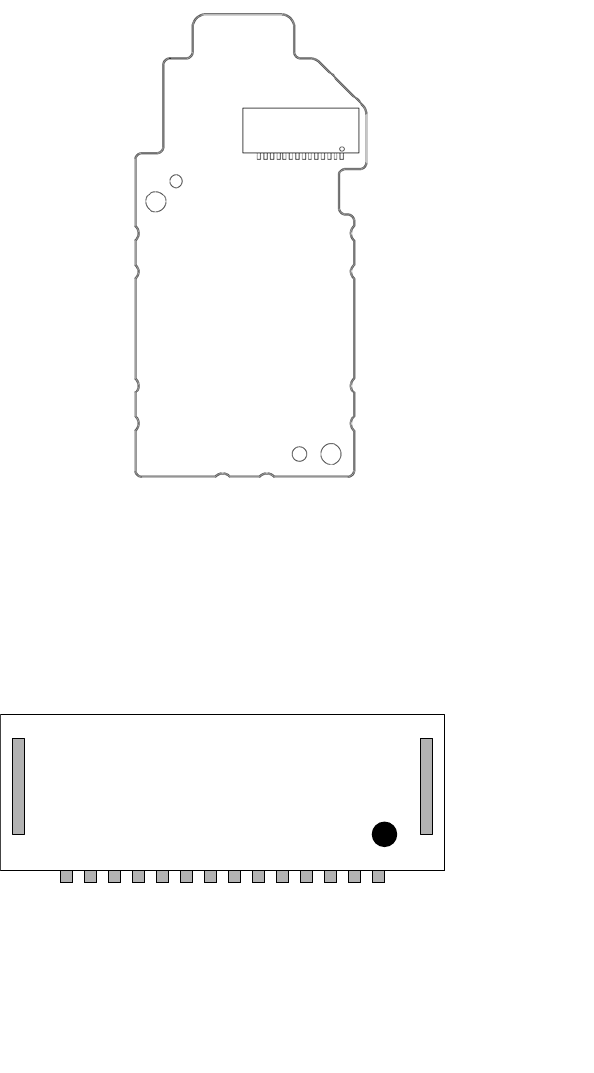Nikon 2142EB 802.11 b/g Transmitter Module User Manual Manual
Nikon Corporation 802.11 b/g Transmitter Module Manual
Nikon >
Manual

UJ-087 Embedded manual
Feeding power and the control are done from connector 14FHJ-SM1-GB made of JST that
exists in the module of Fig.1.
The voltage supplies DC3.3V±0.2V.
The control interface is SDIO.
The Pin layout is as shown in Fig.2.
Fig.1 module outline
1.GND
2.CLK
3.GND
4.CMD
5.DAT0
6.DAT1
7.DAT2
8.DAT3
9.VDD
10.VDD
11.VDD
12.GND
13.GND
14.DET
1.GND
2.CLK
3.GND
4.CMD
5.DAT0
6.DAT1
7.DAT2
8.DAT3
9.VDD
10.VDD
11.VDD
12.GND
13.GND
14.DET
TOP VIEW
Fig.2 PIN layout

There isn’t an official user manual for this Wireless LAN Module (UJ-087). However, user
manuals of final products which have the module, must contain notification corresponding to the
following description.
FCC WARNING
Changes or modifications not expressly approved by the party responsible for compliance could
void the user’s authority to operate the equipment.
NOTICE
This equipment has been tested and found to comply with the limits for a Class B digital device,
pursuant to part 15 of the FCC Rules. These limits are designed to provide reasonable protection
against harmful interference in a residential installation.
This equipment generates, uses and can radiate radio frequency energy and, if not installed and
used in accordance with the instructions, may cause harmful interference to radio
communications. However, there is no guarantee that interference will not occur in a particular
installation. If this equipment does cause harmful interference to radio or television reception,
which can be determined by turning the equipment off and on, the user is encouraged to try to
correct the interference by one or more of the following measures:
-Reorient or relocate the receiving antenna
-Increase the separation between the equipment and receiver.
-Connect the equipment into an outlet on a circuit different from that to which the receiver is
connected.
-Consult the dealer or an experienced radio/TV technician for help.
Properly shielded a grounded cables and connectors must be used for connection to host
computer and / or peripherals in order to meet FCC emission limits. AC adaptor with ferrite core
must be used for RF interference suppression.
This transmitter must not be co-located or operated in conjunction with any other antenna or
transmitter.
For Portable Products;
The available scientific evidence does not show that any health problems are associated with
using low power wireless devices. There is no proof, however, that these low power wireless
devices are absolutely safe. Low power Wireless devices emit low levels of radio frequency
energy (RF) in the microwave range while being used. Whereas high levels of RF can produce
health effects (by heating tissue), exposure to low-level RF that does not produce heating effects
causes no known adverse health effects. Many studies of low-level RF exposures have not found
any biological effects. Some studies have suggested that some biological effects might occur, but
such findings have not been confirmed by additional research. Wireless LAN Module (UJ-087)
has been tested and found to comply with FCC radiation exposure limits set forth for an
uncontrolled equipment and meets the FCC radio frequency (RF) Exposure Guidelines in
Supplement C to OET65. The maximum SAR levels tested for Wireless LAN Module (UJ-087)
has been show to be 0.131 W/kg at Body.

For Mobile Products;
This equipment complies with FCC radiation exposure limits set forth for uncontrolled equipment
and meets the FCC radio frequency (RF) Exposure Guidelines in Supplement C to OET65. This
equipment should be installed and operated with at least 20cm and more between the radiator
and person’s body (excluding extremities: hands, wrists, feet and legs).
This device complies with Part 15 of the FCC Rules. Operation is subject to the following two
conditions: (1) this device may not cause harmful interference, and (2) this device must accept
any interference received, including interference that may cause undesired operation.
IC WARNING
(This device complies with Part 15 of FCC Rules and RSS-Gen of IC Rules)
Operation is subject to the following two conditions: (1) this device may not cause interference,
and (2) this device must accept any interference, including interference that may cause
undesired operation of this device.